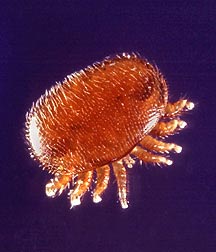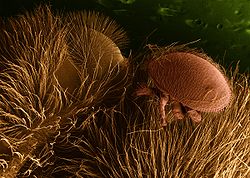Varroa destructor
| Varroa destructor | ||||||||||||||
|---|---|---|---|---|---|---|---|---|---|---|---|---|---|---|
 Varroa destructor, Photo by Scott Bauer
|
||||||||||||||
| Scientific classification | ||||||||||||||
|
||||||||||||||
| Binomial name | ||||||||||||||
| Varroa destructor Anderson & Trueman, 2000 |



Varroa destructor is an external parasitic mite that attacks honey bees Apis cerana and Apis mellifera. The disease caused by the mites is called varroatosis.
Varroa destructor can only replicate in a honey bee colony. It attaches at the body of the bee and weakens the bee by sucking hemolymph. In this process the mite spreads RNA viruses like Deformed Wing Virus to the bee. A significant mite infestation will lead to the death of a honey bee colony, usually in the late autumn through early spring. The Varroa mite is the parasite with the most pronounced economic impact on the beekeeping industry. It may be a contributing factor to Colony Collapse Disorder (CCD) which is threatening hives throughout North America.
Contents |
Physical description
The adult mite is reddish-brown in color; has a flat, button shape; is 1-1.8 mm long and 1.5-2 mm wide; and has eight legs.
Reproduction, infection and hive mortality
Mites reproduce on a 10-day cycle. The female mite enters a honey bee brood cell. As soon as the cell is capped, the Varroa mite lays eggs on the larva which hatch into several females and typically one male. The young mites hatch in about the same time as the young bee develops and leave the cell with the host. When the young bee emerges from the cell after pupation the Varroa mites also leave and spread to other bees and larvae. The mite preferentially infests drone cells.
The adults suck the "blood" of adult honey bees for sustenance, leaving open wounds. The compromised adult bees are more prone to infections. With the exception of some resistance in the Russian strains, the European Apis mellifera bees are almost completely defenseless against these parasites (Russian honey bees are one third to one half less susceptible to mite reproduction [1]). Eastern Apis cerana honey bee has developed grooming procedures that remove these parasites so they are not a threat to these hives.
The model for the population dynamics is exponential growth when bee brood are available and exponential decline when no brood is available. In 12 weeks the number of mites in a Western honey bee hive can multiply by (roughly) 12. High mite populations in the fall can cause a crisis when drone rearing ceases and the mites switch to worker larvae, causing a quick population crash and often hive death.
Varroa mites have been found on flower feeding insects such as the bumblebee Bombus pennsylvanicus, the scarab beetle Phanaeus vindex and the flower-fly Palpada vinetorum (Kevan et al. 1990). Although the Varroa mite cannot reproduce on these insects, its presence on them may be a means by which it spreads short distances (phoresy).
Introduction around the world
- Early 1960s Japan, USSR
- 1960s-1970s Eastern Europe
- 1971 Brazil
- Late 1970s South America
- 1982 France
- 1984 Switzerland, Spain, Italy
- 1987 Portugal
- 1987 USA
- 1989 Canada
- 1992 England
- 2000 New Zealand (North Island)
- 2006 New Zealand (South Island) [1]
- 2007 Hawaiian Islands [2][3]
Identification
Varroa destructor was, until recently, thought to be a closely related mite species called Varroa jacobsoni. Both species parasitize the Asian honey bee, Apis cerana. However, the species originally described as V. jacobsoni by Oudemans in 1904 is not the same species that also attacks Apis mellifera. The jump to mellifera probably first took place in the Philippines in the early 1960s where imported Apis mellifera came into close contact with infected Apis cerana. Up until 2000, scientists had not identified Varroa destructor as a separate species. This late identification in 2000 by Anderson and Trueman corrected some previous confusion and mislabeling in the scientific literature. As of 2005, the only Varroa mites that can reproduce in colonies of Apis mellifera (Western honeybee) are the Korea and Japan/Thailand genotypes of Varroa destructor.
Control or preventive measures and treatment
Chemical measures
Varroa mites can be treated with commercially-available miticides. Miticides must be applied carefully to minimize the contamination of honey that might be consumed by humans. Proper use of miticides also slows the development of resistance of the mites.
Synthetic chemicals
- pyrethroid insecticide (Apistan) as strips
- organophosphate insecticide (Coumaphos (Check-mite)) as strips
Natural occurring chemicals
- Essential oil especially lemon, mint, and thyme oil
- sugar esters (Sucrocide) in spray application
- oxalic acid trickling method or applied as vapor (Dany's BienenWohl or VARROX-Vaporiser)
- formic acid as vapor or pads
- Foodgrade mineral oil as vapor and in direct application on paper or cords.
Physical or mechanical methods
Varroa mites can also be controlled through non-chemical means. Most of these controls are intended to reduce the mite population to a manageable level, not to eliminate the mites completely.
- Many beekeepers use a screened bottom board on their hives. When mites occasionally fall off a bee, they must climb back up to parasitize a new bee. If the beehive has a screened floor with mesh the right size, the mite will fall through and can not return to the beehive. The screened bottom board is also being credited with increased circulation of air which reduces condensation in a hive during the winter. (Studies at Cornell University done over two years found that screened bottoms have no measurable effect at all. Northeast Beekeeper Vol 1 #1 Jan 2004)
- Screened bottom board with sticky board. It separates mites that fall through the screen and the sticky board prevents them from crawling back up.
- Small cell foundation (4.9 mm across - about 0.5 mm smaller than standard) is believed to limit the space in each cell that Varroa mites have in which to inhabit and also to enhance the difference in size between worker and drone brood with the intention of making the drone comb traps more effective in trapping Varroa mites. Small cell foundation has staunch advocates though controlled studies have been generally inconclusive.
Behavioral methods
- Powdered sugar (Dowda Method), talc or other "safe" powders with a grain size between 5 and 15 micrometres can be sprinkled on the bees. The powder does not harm the bees (and, in the case of sugar, can even become a small food source), but does interfere with the mite's ability to maintain its hold on the bee. It is also believed to increase the bees' grooming behavior. This causes a certain percentage of mites to become dislodged. Powdered sugar works best as an amplifier of the effects of a screened bottom board.
- Freezing drone brood takes advantage of Varroa mites' preference for longer living drone brood. The beekeeper will put a frame in the hive that is sized to encourage the queen to lay primarily drone brood. Once the brood is capped, the beekeeper removes the frame and puts it in the freezer. This kills the Varroa mites that are feeding off of those bees. It also kills the drone brood, but most hives produce an excess of drone bees so it is not generally considered a loss. After freezing, the frame can be returned to the hive. The nurse bees will clean out the dead brood (and dead mites) and the cycle continues.
- Drone brood excision is a variation applicable to top bar hives. Honey bees tend to place comb suitable for drone brood along the bottom and outer margins of the comb. Cutting this off at a late stage of development ("purple eye stage") and discarding it reduces the mite load on the colony. It also allows for inspection and counting of varroa on the brood.
- Swarming or queen-arrest method. By interrupting the honey bee brood cycle, mites reproduction is also blocked.
- Hygienic Behavior. Hygienic behavior is biological behavior with genetic traits that can be bred into bees. This behavior causes bees to smell infected brood and remove them before the infestation spreads further.[4]
Varroatosis
The infection and subsequent parasitic disease caused by varroa mites is called varroatosis. Its treatment has been of limited success. First the bees were medicated with fluvalinate which had about 95% mite falls. However the last five percent became resistant to it and later, almost immune. Fluvalinate was followed by coumaphos.
References
- ^ Anderson, D & Trueman, J. W. H. (2000). "Varroa jacobsoni (Acari: Varroidae) is more than one species." Experimental & Applied Acarology, 24, 165-189.
- ^ ZHANG, ZHI-QIANG Notes on Varroa destructor (Acari: Varroidae) parasitic on honeybees in New Zealand Systematic & Applied Acarology Special Publications (2000) 5, 9-14
- ^ Delaplane, Keith S. Varroa destructor: Revolution in the Making University of Georgia; Bee World; 2001; 82(4): 157-159
- British Ministry of Agriculture, Fisheries and Food Managing varroa , 2005
- Kevan, P., et al. 1990 Association of Varroa jacobsoni with organisms other than honeybees and implications for its dispersal. Bee World 71: 3, 119-121.
- Tracheal and Varroa Mite Controls Apiculture Factsheet #221, Ministry of Agriculture, Food and Fisheries, Government of British Columbia; April 2004
- Oils for Varroa Control Botanicals For Mite Control, Canadian Honey Council, 3/16/2003
Notes
- ↑ Varroa Mite | MAF Biosecurity New Zealand
- ↑ Images in the news - chicagotribune.com
- ↑ starbulletin.com | Business | /2007/04/25/
- ↑ "A Sustainable Approach to Controlling Honey Bee Diseases and Varroa Mites". SARE. Retrieved on 2008-11-18.
External links
- Natural Cell Size for Varroa Control
- Small Cell Beekeepers Group
- Using Powdered Sugar for Varroa Mite Control
- Varroa mite on the UF / IFAS Featured Creatures Web site
The Swiss Bee Research Centre scientifically investigated the life cycle of the varroa in the capped cell and described it in a paper (A Look under the cap).